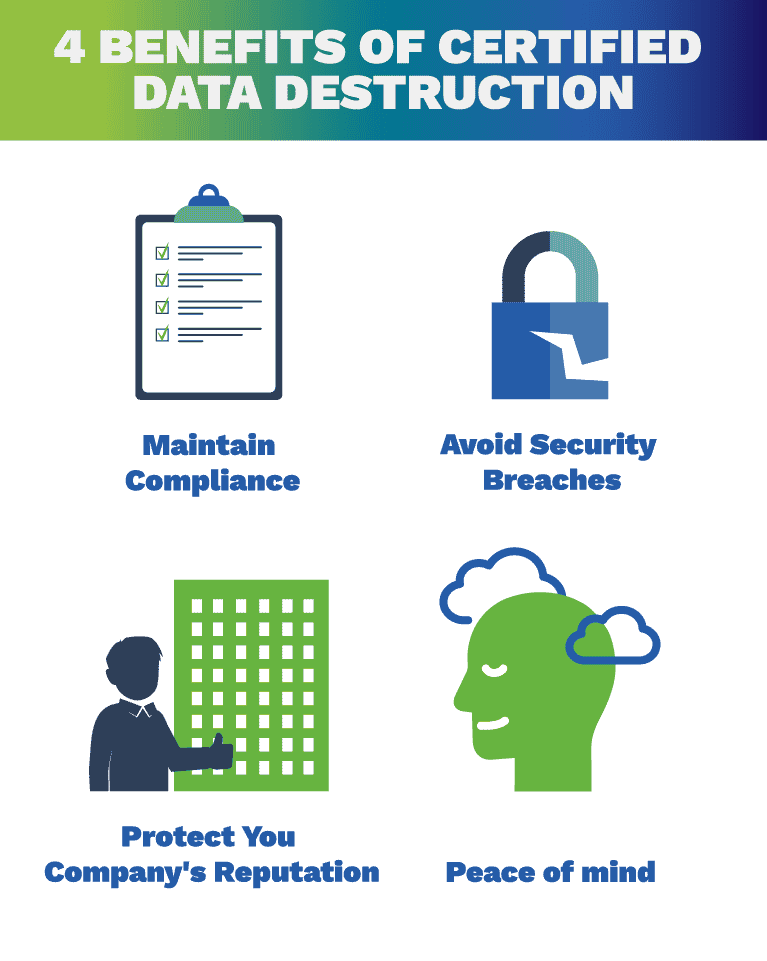Important Cyber Security Practices for Effective Data Destruction Strategies
Wiki Article
The Significance of Effective Data Damage Practices in Shielding Sensitive Details and Ensuring Computer Safety
In a period where information breaches are increasingly typical, the value of reliable information destruction methods can not be overstated. Organizations face considerable threats when delicate details is improperly disposed of, potentially causing unapproved accessibility and severe financial repercussions. Implementing robust data destruction methods not only reduces these threats however likewise lines up with legal compliance requirements, ensuring that organizations support their credibility and foster client trust. However, the question continues to be: what details approaches can be employed to enhance these practices, and just how can companies successfully integrate them into their total cybersecurity structure?Recognizing Data Devastation
Comprehending information damage is essential in today's electronic landscape, where delicate info can quickly be jeopardized. Reliable data devastation includes not merely guaranteeing yet deleting files that information is irretrievable via extensive approaches. This process is necessary for organizations that deal with personal customer details, copyright, or internal papers, as any kind of violation can result in serious economic and reputational effects.
Data destruction includes various methods, consisting of shredding physical media, degaussing magnetic storage space tools, and employing software-based services that overwrite data numerous times. Each approach offers a specific function and needs to straighten with the level of sensitivity of the information being taken care of. For instance, physical destruction is frequently preferred for hard disks including extremely private information, while software program methods may be enough for less sensitive information.
Moreover, adhering to sector criteria and guidelines, such as the General Data Protection Regulation (GDPR) or the Medical Insurance Transportability and Responsibility Act (HIPAA), is critical for conformity and to alleviate legal threats. Organizations has to establish a robust information damage policy, train employees on ideal methods, and frequently audit their treatments to make sure that all sensitive details is thrown away securely and effectively.
Threats of Inadequate Practices
Poor information damage practices expose companies to considerable risks that can have significant consequences. When sensitive details is not appropriately taken care of, it stays susceptible to unauthorized access, which can result in data violations and identity theft. Such incidents not just jeopardize the safety and security of individuals yet also stain the organization's credibility, causing a loss of client trust and prospective financial repercussions.Moreover, regulatory conformity is significantly strict in several markets. Failing to abide by data damage laws can result in significant penalties and lawful actions versus companies. These fines can stress financial resources and divert interest from core service procedures.
In enhancement, the misuse of residual data can cause copyright burglary or company reconnaissance, threatening competitive benefits (data destruction). The impact of inadequate data destruction prolongs beyond instant monetary losses; it can likewise lead to lasting damages to brand name stability and market setting

Organizations have to identify that information security is not solely about preventing breaches; it also incorporates the liable monitoring of information throughout its lifecycle. Disregarding reliable information damage procedures can have catastrophic implications, underscoring the need for durable procedures to alleviate these dangers.
Best Practices for Information Devastation
Executing effective data devastation methods is vital for protecting sensitive details and keeping compliance with governing criteria. Organizations ought to like this adopt a multi-faceted strategy to make certain that information is irretrievable, thus stopping unauthorized access and possible breaches.First, data need to be categorized based upon level of sensitivity, allowing companies to apply ideal damage methods customized to the level of threat. For electronic information, making use of software-based data-wiping devices that follow market standards can effectively overwrite existing information. Physical destruction techniques, such as shredding or degaussing, are essential for tools that store delicate details, ensuring total removal.
Developing a clear data retention plan is vital, outlining the length of time various types of info should be maintained prior to destruction. Normal audits of data storage systems are additionally necessary to determine unnecessary or obsolete data needing elimination.
Furthermore, training employees on the value of information destruction and the particular methods to comply with fosters a culture of safety within the company. Keeping documentation of data destruction processes offers responsibility and sustains compliance with exterior laws and inner plans. By adhering to these best methods, companies can dramatically minimize the risks associated with information direct exposure.
Legal and Conformity Factors To Consider

Failing to abide by these guidelines can cause severe charges, consisting of substantial fines and reputational damage. Organizations has to implement a robust information devastation plan that aligns with these legal structures and gives clear standards on the proper methods of data disposal, whether physical shredding or digital wiping.
Additionally, keeping documentation of data destruction activities is important for showing conformity during audits or assessments. By focusing on lawful and conformity factors to consider, organizations can enhance their data security position and foster count on with clients and stakeholders, eventually contributing to a much more protected data administration atmosphere.
Benefits of Effective Data Devastation
Reliable information damage methods prolong beyond plain conformity; they use considerable benefits to organizations that prioritize them. By guaranteeing that sensitive information is irretrievably damaged, organizations reduce the risk of data violations and the prospective monetary consequences related to them. This proactive strategy not just safeguards against unauthorized gain access to however also enhances the total dependability of the organization in the eyes of clients and stakeholders.Applying durable data destruction approaches, such as physical devastation of storage space gadgets or advanced information cleaning techniques, adds to the conditioning of an organization's cybersecurity stance. data destruction. It minimizes the probability of copyright theft and protects exclusive information, therefore preserving an one-upmanship on the market

Final Thought
To conclude, efficient data damage techniques are important for securing delicate details and enhancing overall computer safety. By applying comprehensive methods such as software application, degaussing, and shredding overwriting, companies can alleviate the threats linked with unapproved accessibility and information violations. Adherence to governing criteria, consisting of GDPR and HIPAA, more reinforces conformity and shields versus click to read lawful consequences. Eventually, a commitment to robust data devastation strategies cultivates a society of duty, consequently reinforcing a company's cybersecurity pose and preserving customer count on.
Report this wiki page